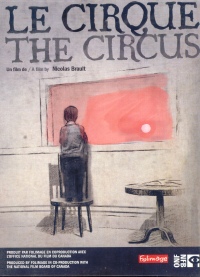| ________________
CM . . . . Volume XIX Number 40 . . . . June 14, 2013
The Circus relates the story of a son who is denied time with his hospitalized mother by ostensibly good-intentioned but insensitive adults. Filmmaker Nicolas Brault deems this animation a "transposition of a real-life experience" which no doubt accounts for the emotional authenticity it conveys. Uncomplicated by dialogue, the film relies on images, music, and sound effects to evoke sentiments that resonate long after its seven minutes are up. The film opens in a hospital waiting room, where a solitary young boy peers into an adjoining room through a window in the wall. The reddish pulse of a cardiac monitor holds his attention, until a visitor's arrival interrupts his silent vigil. As the woman crosses the threshold of the outer door, frost materializes under her feet, spreading to the floor, the wall, and also the window, thereby obscuring the boy's view. Her gruff laughter, at odds with the comforting background music, seems menacing. Shortly after that, more visitors converge in the waiting room before squeezing as one into his mother's sickroom. There they circle around the bed to circus-like music which, in conjunction with their muffled "ha-ha-has", generates a weird atmosphere. The boy desperately scrambles to reach his mother, but only once the monitor stills and after the "circus" exits does he have any opportunity to be alone with her. In a flashback, the mother and son play in the snow as a woman's voice hums a lullaby and a child laughs. The mother hugs her son before succumbing to the frost that begins to form over her. The final image returns the viewer to the present where the boy is curled up next to his mother's body. The animation concludes with a line of text that reads "À ma mere/To my mother." The DVD includes an "Interview with Nicolas Brault" (in French with English subtitles), in which the filmmaker discusses the impetus for The Circus as well as the animation technique it employs. Brault shares that the film stems from the loss of his mother in the aftermath of the Quebec Ice Storm of 1998. At the same time, he notes that he altered details; for instance, whereas Brault was 20-years-old when his mother died, the film's protagonist is significantly younger, about five or six. The change in age heightens the dramatic tension between the main character and the antagonists. Not only is there disparity in size, but additional touches, such as the adults' stooped posture and shuffling movements, further highlight the generational divide. All in all, the boy's youthfulness accentuates his isolation and vulnerability so that a viewer cannot help but sympathize with him. Altered details, then, add conflict and interest to the film's unfolding action. For The Circus, Brault employs an animation technique called rotoscopy. Rotoscopy, he explains in the interview, uses computer software to convert live-action footage to images that simulate charcoal drawings. As a consequence, the predominantly black and white scenes intensify the film's somber atmosphere. Color is used sparingly, yet purposefully: a reddish-pink glow links the monitor from the beginning of the film to the blanket that covers the boy's mother in the middle section and also to the boy's sweater in the final scene. In fact, the sweater seems to have absorbed all the color that previously emanated from the blanket, and that reddish tinge denotes warmth and life amidst the cold, bleak surroundings. Effectively, the animation expresses visually the feelings of anxiety and grief that are too difficult to articulate. As a bonus, after The Circus and the interview with Brault, the DVD's main menu lists a third feature entitled "Animation at NFB." This section showcases an impressive number of samples and trailers of historical and contemporary animated films produced by the National Film Board in whole or in part. Viewers have access to over thirteen minutes of animations that enlist different themes and techniques. These trailers are available in both official languages, as are the DVD's other two menu items. The Circus is highly recommended, but with a cautionary note that, because it portrays a death, viewer discretion is advised. Parents would likely prefer to address the subjects of death and dying with their children themselves, privately, within the context of their personal beliefs. Accordingly, The Circus is better suited to recreational viewing than as classroom support-unless the instruction pertains to animation, film studies, filmmaking, counselling, or art therapy. On the whole, Brault deserves accolades for parsing complicated emotions into a comprehensible and compelling animation. Highly Recommended. Julie Chychota lives in Ottawa, ON., and facilitates communication for individuals with hearing disabilities by capturing speech as text on her trusty laptop.
To comment
on this title or this review, send mail to cm@umanitoba.ca.
Copyright © the Manitoba Library Association. Reproduction for personal
use is permitted only if this copyright notice is maintained. Any
other reproduction is prohibited without permission.
NEXT REVIEW |
TABLE OF CONTENTS FOR THIS ISSUE
- June 14, 2013.
AUTHORS |
TITLES |
MEDIA REVIEWS |
PROFILES |
BACK ISSUES |
SEARCH |
CMARCHIVE |
HOME |
